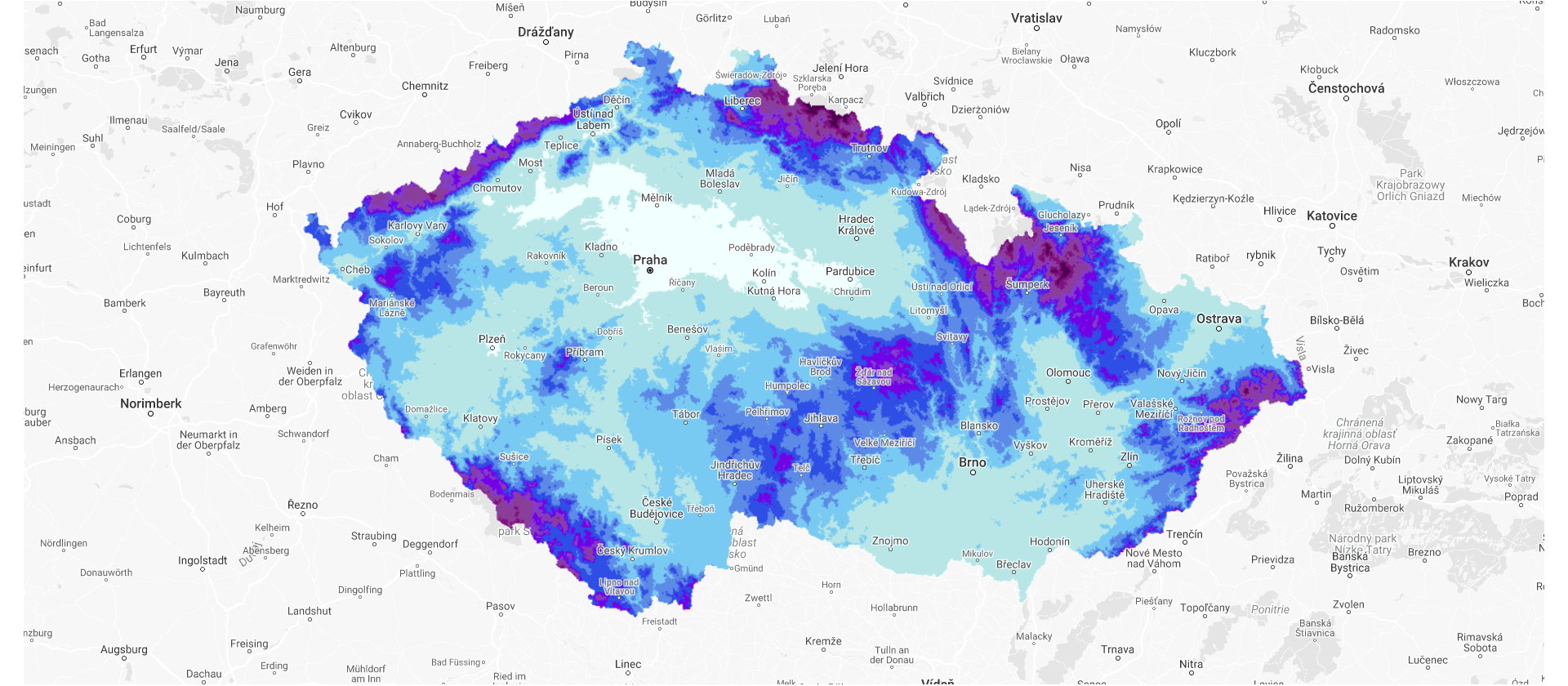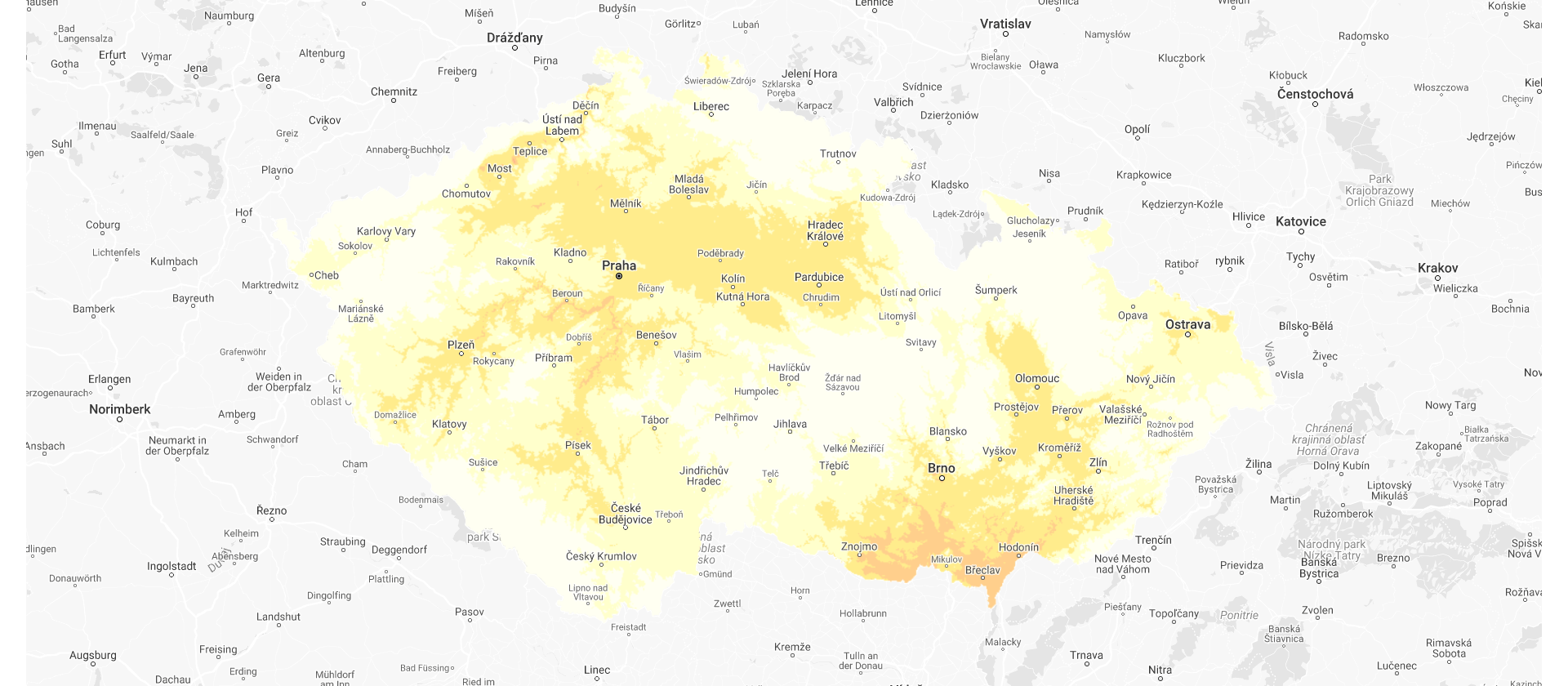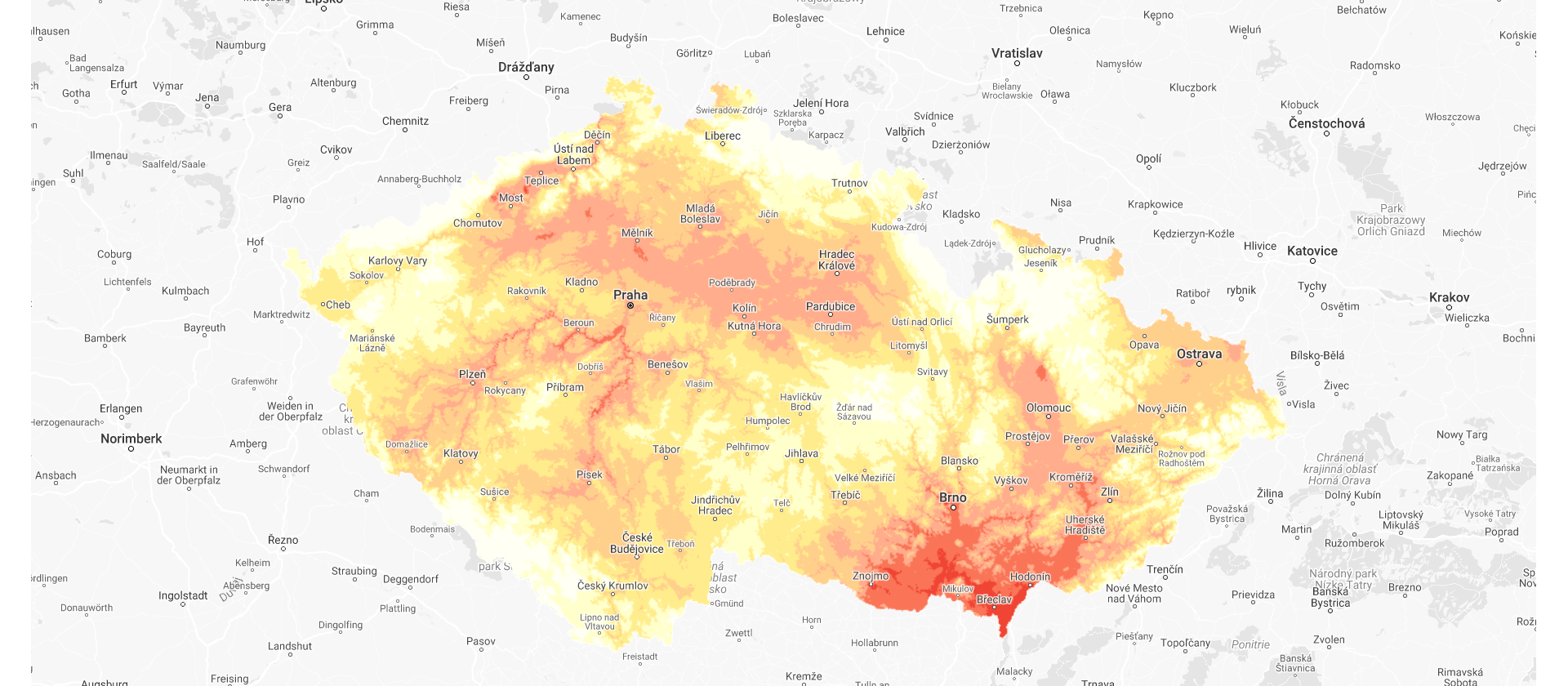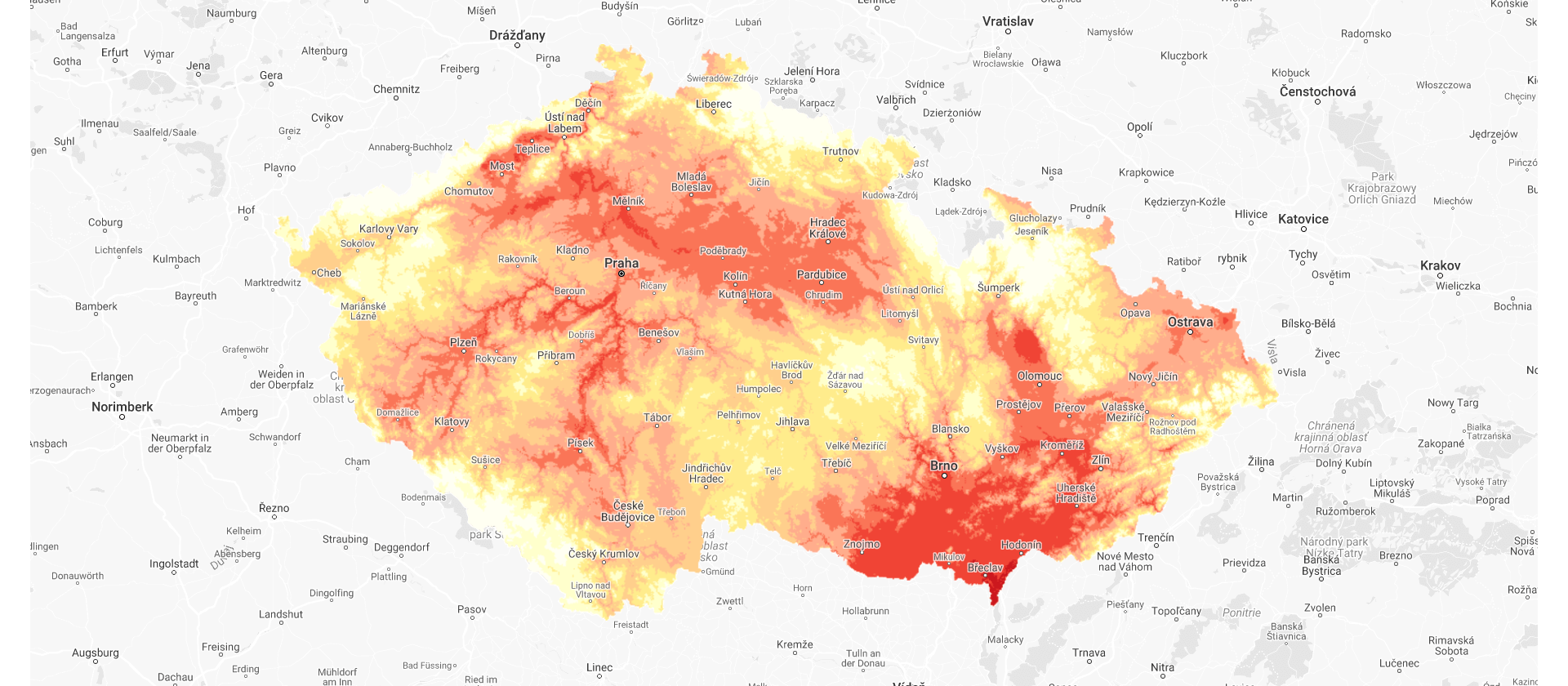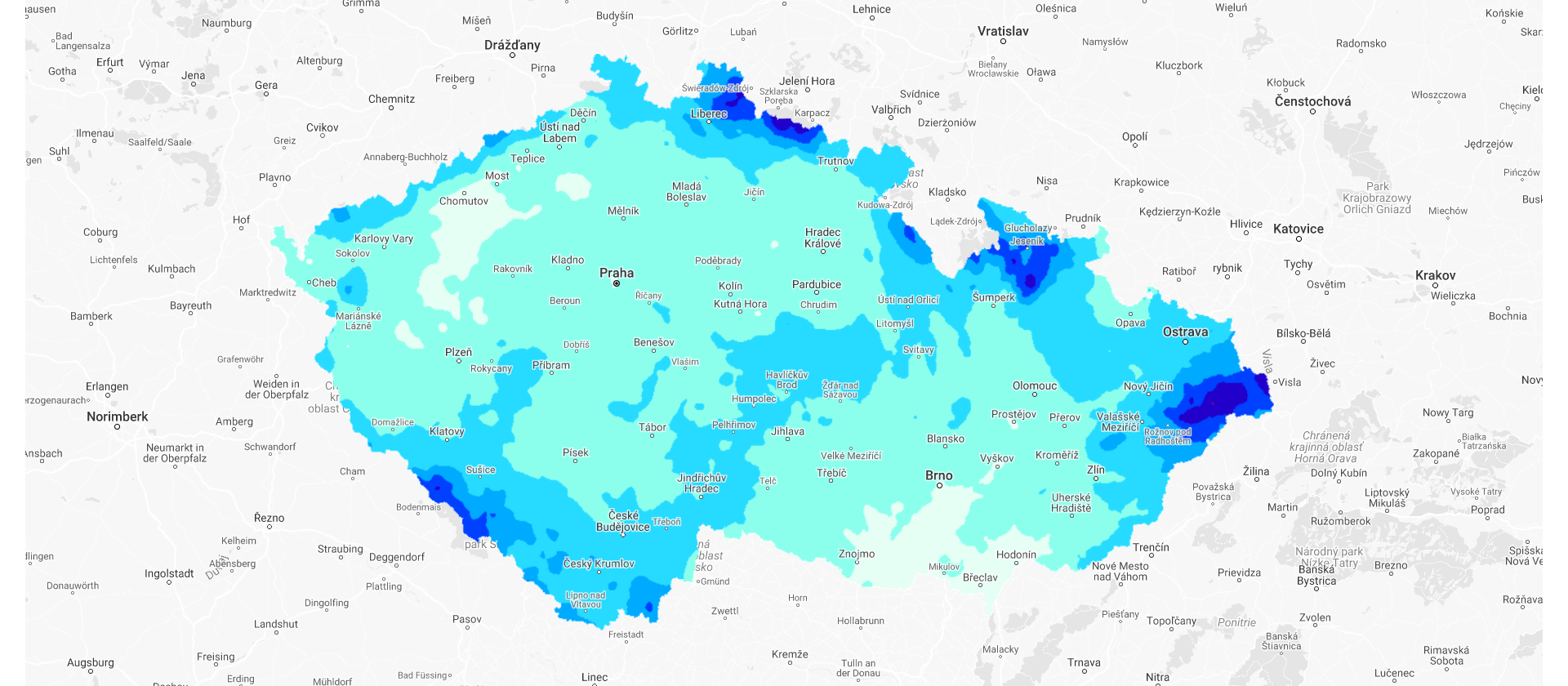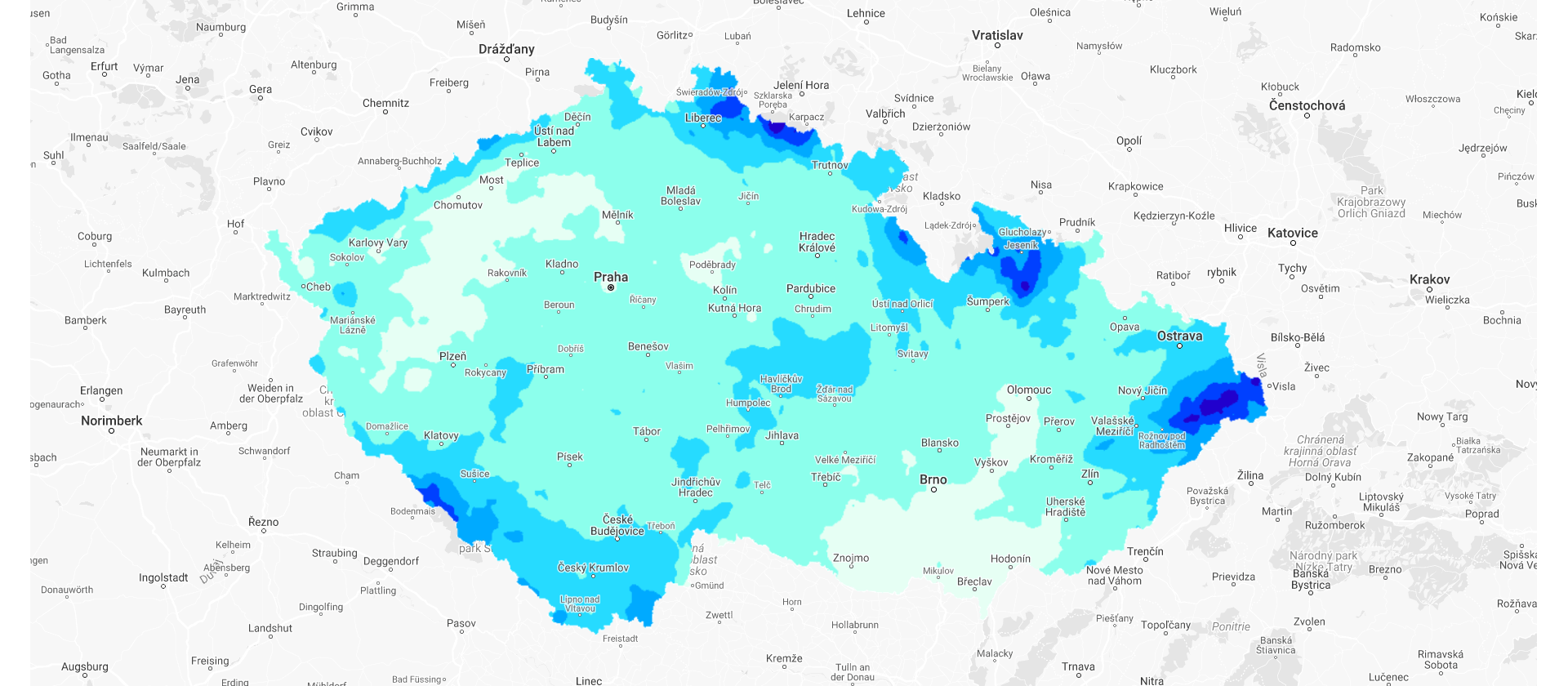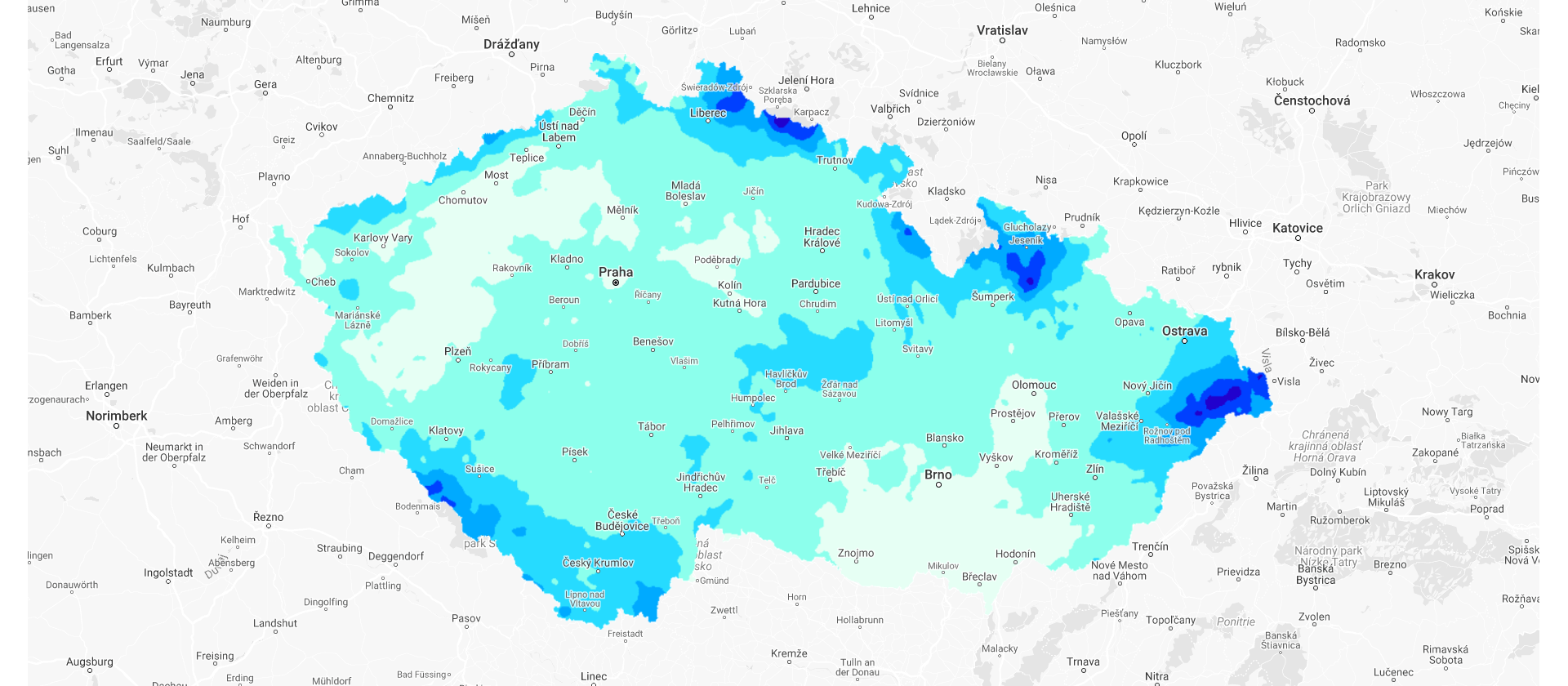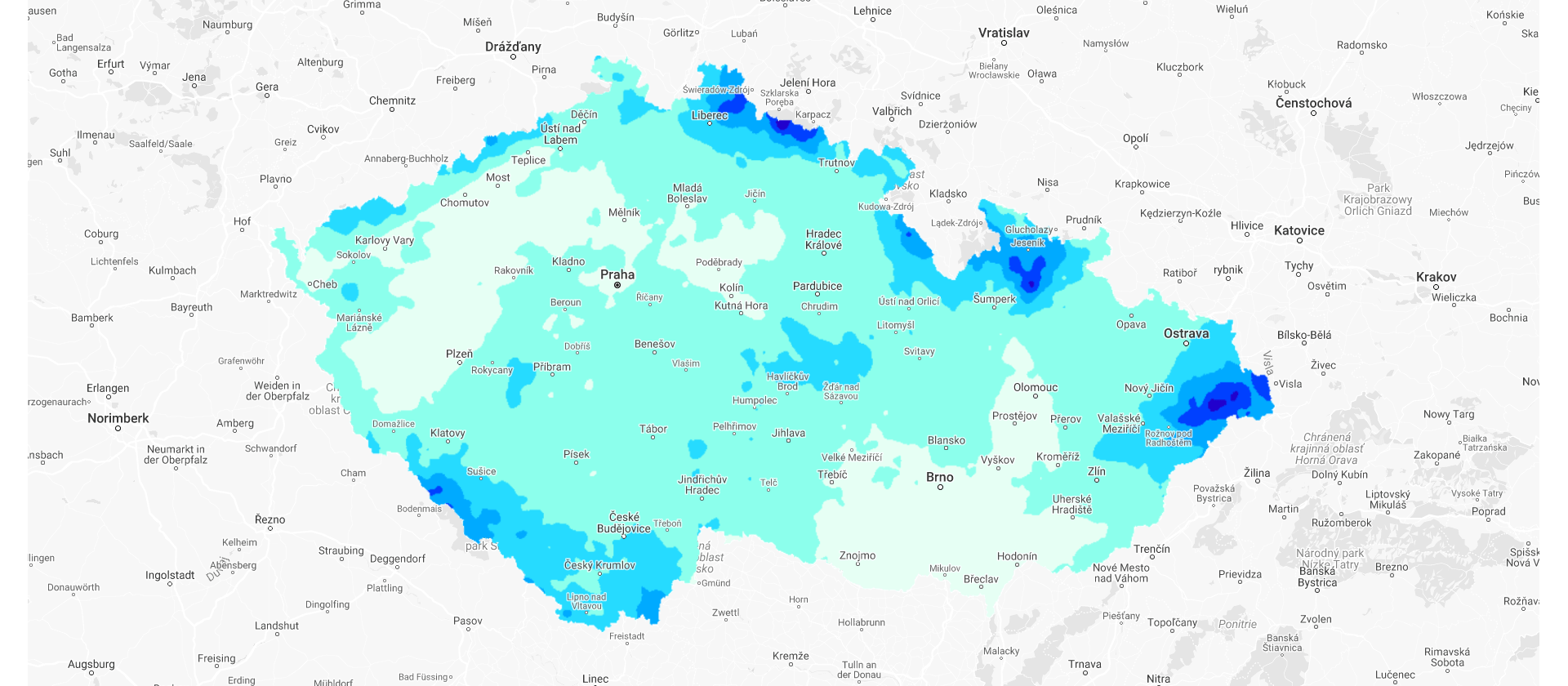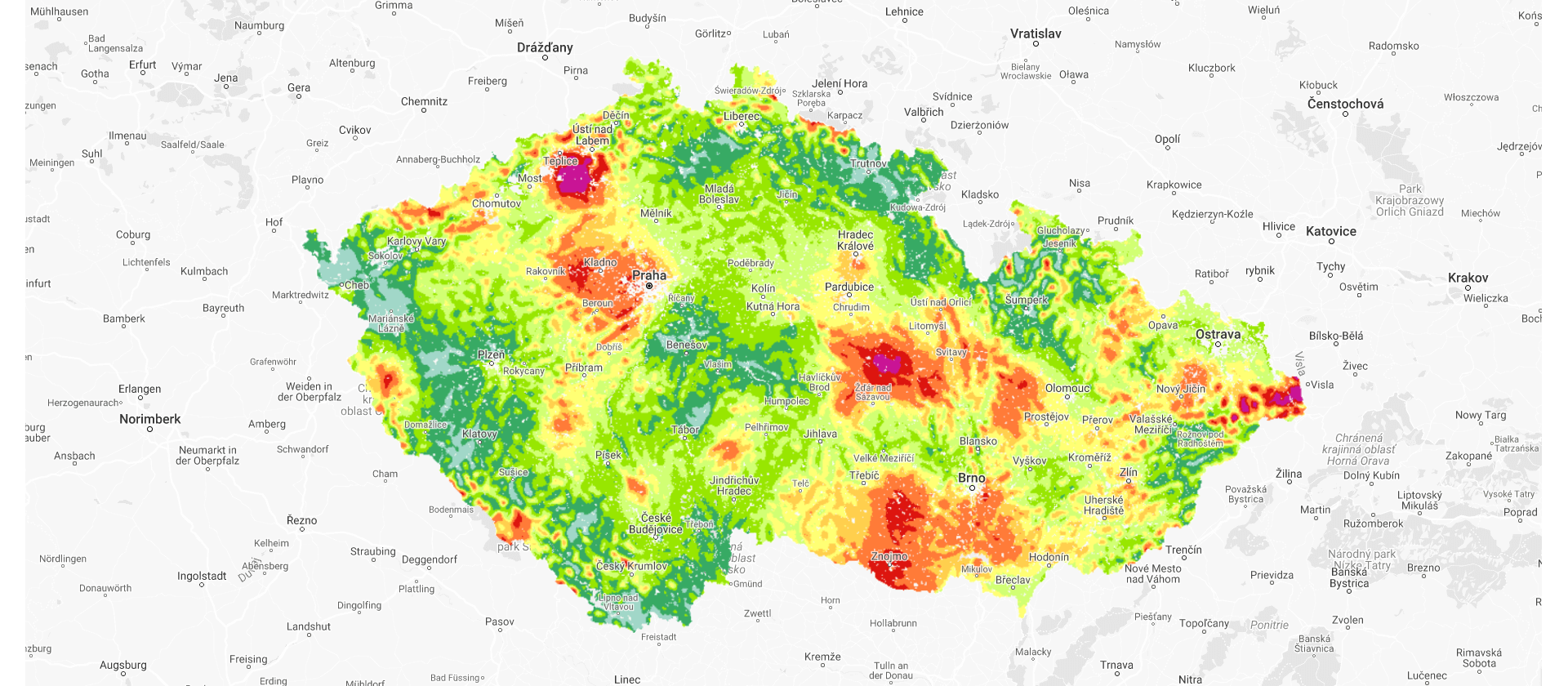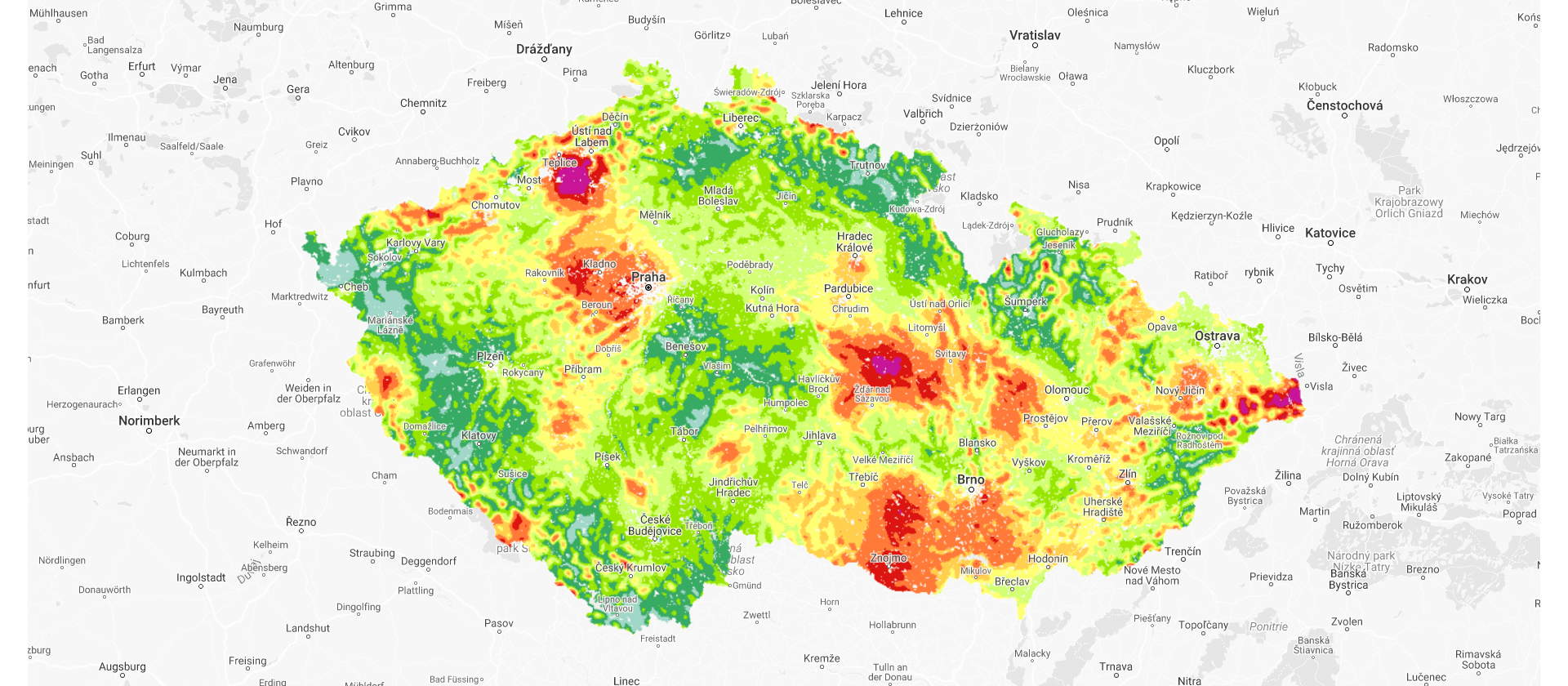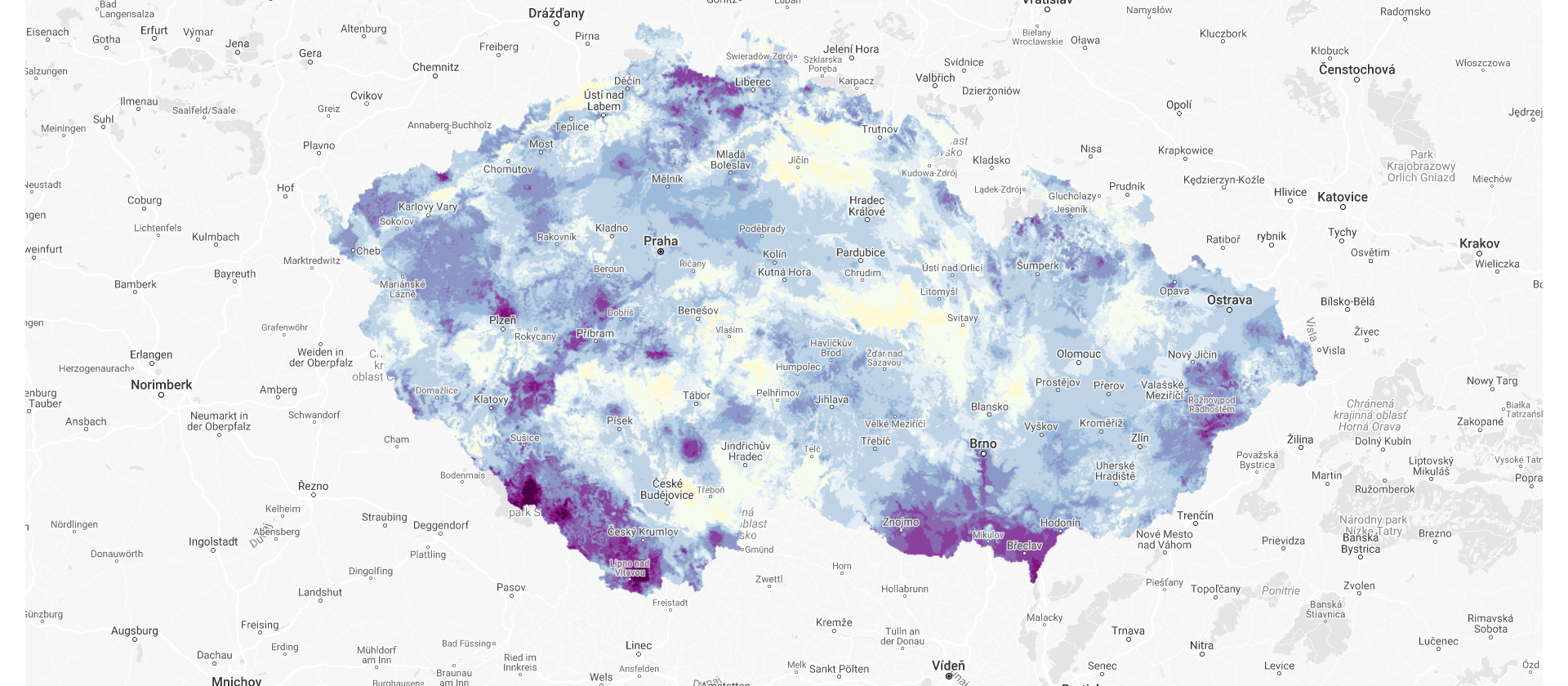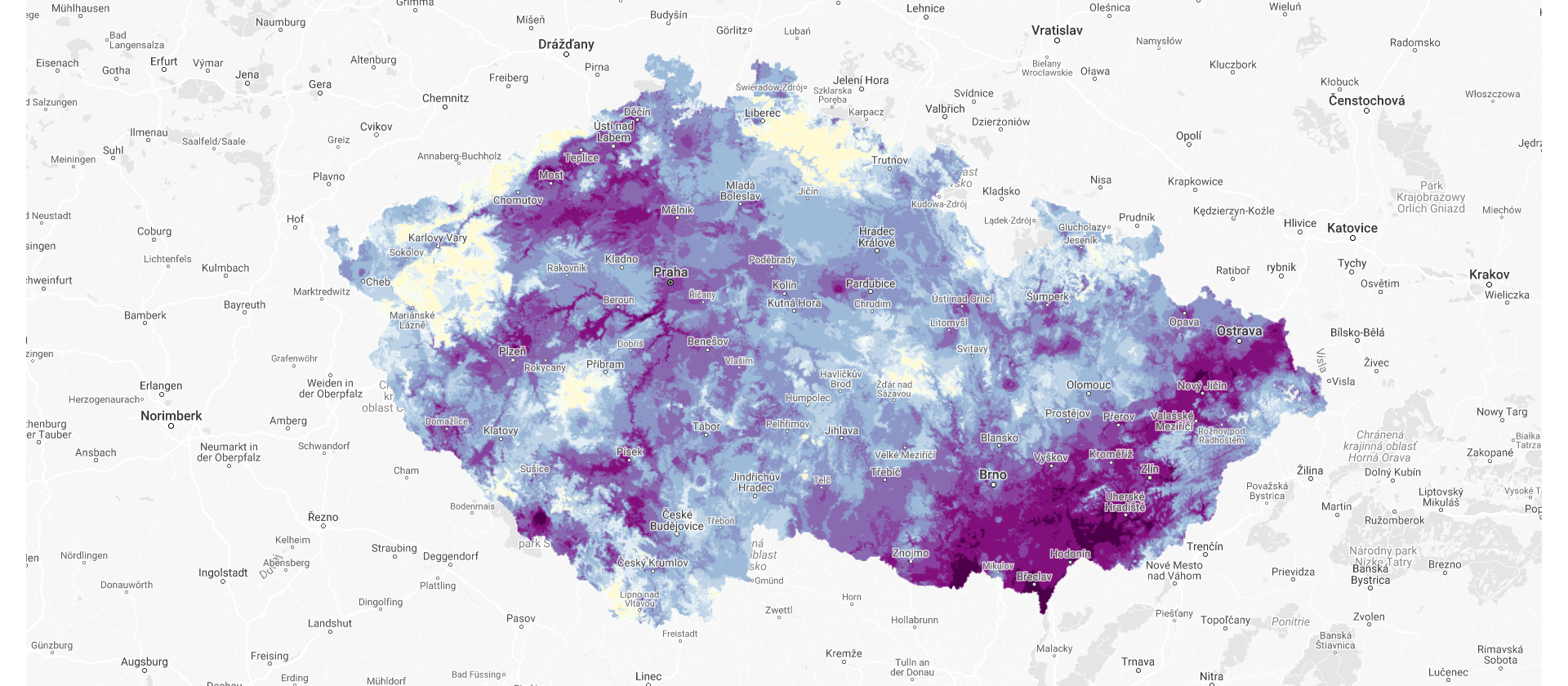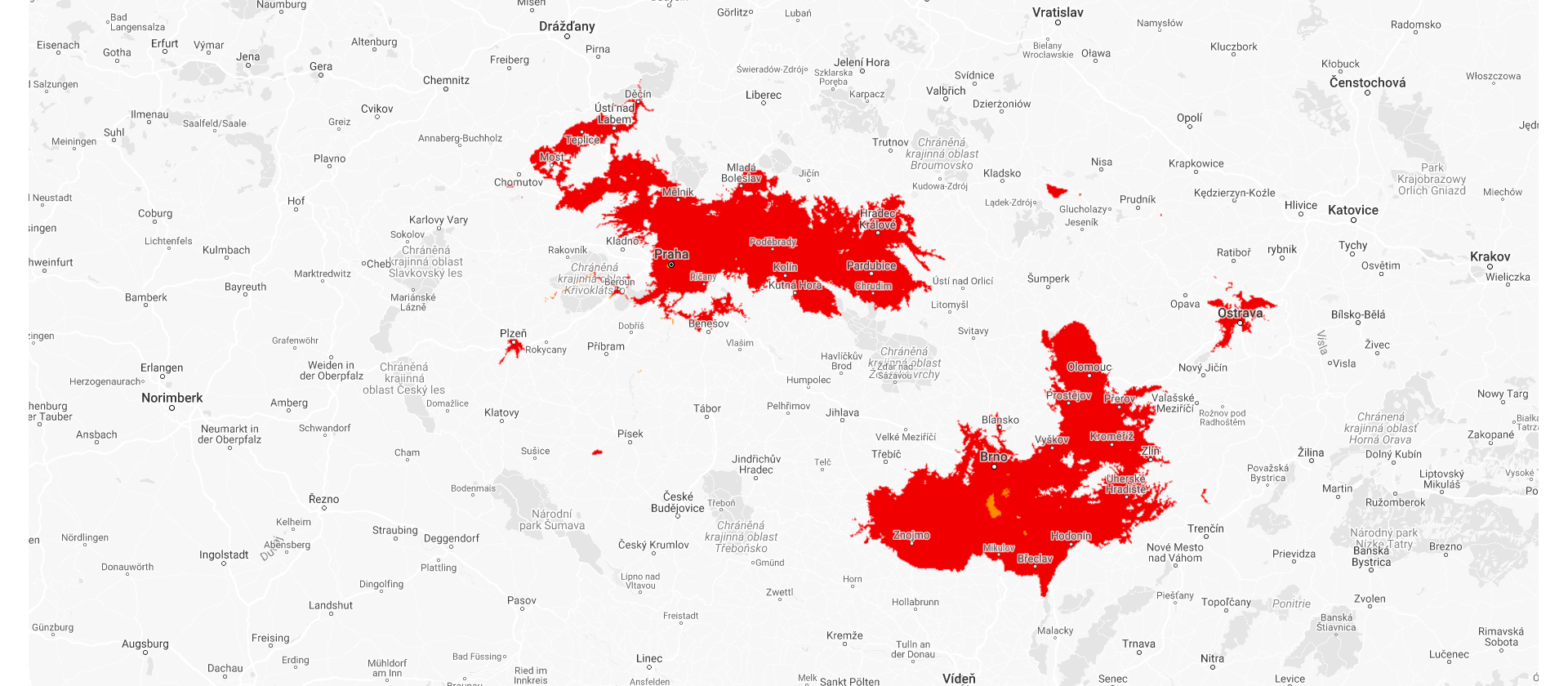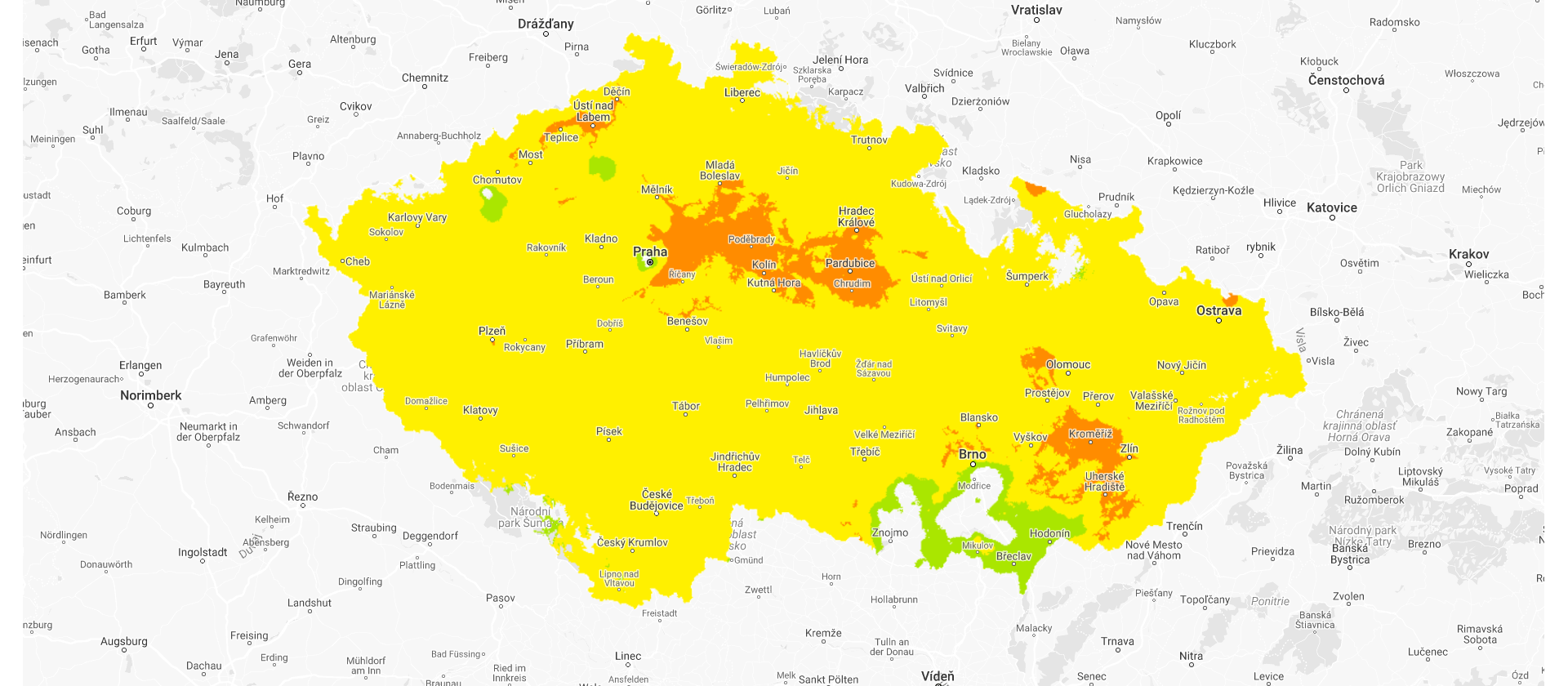Climate change
Climate in the Czech Republic
Diseased forests, barren fields, dry landscapes, and the extinction of animal species. These are the effects of climate change and the unsustainable use of natural resources. Such effects are permanently transforming our country. However, by rethinking our lifestyles, and through the timely implementation of functional adaptation and mitigation measures, we can move away from unsustainable practices and benefit from the quality of life improvements that go hand-in-hand with a thriving natural environment.
OUR PROJECTs IN CZECHIA
Changed country
01Is the Czech Republic becoming like the Mediterranean?
The Czech Republic is warming. This is most visible during the winter and summer months. In winter, it freezes or snows less frequently than in the past. In the summer, the number of tropical days and heavy rains have increased. As a result, our vegetation will slowly become similar to that of the Mediterranean.
The average temperature has increased by around 2.4° C in the Czech Republic since 1850. By 2050, it is expected to increase by approximately 1.4 to 1.9°C. However degree of further warming depends on the amount of greenhouse gases we continue to release, and many forests will disappear from our landscape. Without dramatic action to prevent warming, we can expect an increase in global temperatures by 4°C in Czech Republic by the end of the century compared to 1981-2010. This would have significant consequences.
More on warming scenarios

Deforestation
The villagers of Smrčná, near Větrný Jeníkov, have always been proud of the dense forests surrounding their village. No matter which direction Zuzana and her six-year-old daughter, Magdalena, set out for a walk, they would soon be surrounded by dense, mostly coniferous trees. Magda played in the woods, learned to recognise different species of insects and plants, collected mushrooms, listened to the birds, and built small dams on the streams with other local children.
That was in 2003. In the meantime, Magda grew up, left to go work in the UK, got married, and started a family. This year, she returned for a long-anticipated visit to Smrčná to show her husband and three-year-old son where she spent her childhood. But she found the beautiful forest of her memories in ruins: what confronted her was a clearing with a scattering of dead trees, stumps, a few thorns and bushes. The forest was unrecognisable, and it would be impossible to teach her son to recognise the plants, mushrooms, and animals of her childhood.
As a direct result of climate change, droughts have plagued Central Europe with increasing frequency in recent years. These droughts have weakened forests and wreaked havoc on old and diseased trees. Drought-weakened and densely planted groups of conifers have also become easy prey for the bark beetle. The bark beetle has thrived, multiplied, and caused enormous damage within a few short years - devastating even young, healthy trees. Not only have forests changed beyond recognition, but many species of animals, birds, insects, and plants have all but disappeared. Damaged vegetation retains far less water. And with depleted forest, there is nothing to stand in the way of the wind, which causes erosion, especially on large tracts of farmland. This threatens the biodiversity of not only the forest itself, but of the surrounding landscape.
What awaits us?
02Lack of water
The Czech landscape has faced occasional droughts in the past, but never on today’s scale. Between 2015 and 2021, the Czech Republic experienced both its worst drought - caused by a lack of precipitation and the hottest temperatures on record. (Source: Institute of Global Change Research AS CR).
Source: Ústav výzkumu globální změny AV ČRDrought
While previous droughts were largely caused by prolonged periods without precipitation, today this is exacerbated by the evaporation of water from the landscape due to high ambient air temperatures. Any future warming will lead to droughts that our landscape will have trouble recovering from.


Poor water quality
Higher temperatures lead to increased activity of micro-organisms in the water and higher levels of putrefaction. Higher temperatures also reduce ability of the water to dissolve oxygen. Higher nutrient concentrations result in to the proliferation of toxic cyanobacteria. This phenomenon, together with pollution caused by human activity, threaten to significantly degrade the quality of surface and subsurface waters. A shortage of clean water will endanger the health of the population, lead to reduced economic production as water becomes too scarce to grow plants for livestock, increase the risk from fires, and cause harm to forests. Energy production will be affected as well, as hot or polluted water cannot be used to generate electricity.
Shortage of snow
Higher temperatures in winter cause snow to melt faster and lead to precipitation in the form of rain instead. This is a problem not only for skiers and ski area operators, but also for the landscape. The gradual melting of snow helps to saturate soil over a longer period of time, making it available for agricultural uses, among others, in the spring when the plants have already started to grow and draw nutrients from the soil. Rainfall cannot replace the gradual melting of snow. Instead, they quickly run off into the rivers.


Dry land
2018 was just one in a series of extremely hot and dry years. The average annual air temperature across the country—9.6°C— was 1.7°C above the 1981 to 2010 avarage. Annual rainfall in the Czech Republic in 2018—522 mm—was only 76 percent of the 1981 to 2010 avarage. As it had already been unseasonably dry for several consecutive years, the conditions in 2018 exacerbated the already low water levels in the landscape, streams, and groundwater, making the signs of drought all the more pronounced.
In places such as Zruč nad Sázavou, 2018 brought extreme drought conditions. In August 2018, the daily flows of the Sázava River fell well below average—up to one quarter the flow of previous years— making the riverbed visible in some areas. Such consequences affect not only boaters, when the flow of any river is reduced so dramatically, several parallel processes occur: shallow and slow-flowing or standing water is thermally unstable and warms up more easily (the Sázava, for instance, was over 20° in the summer months) but cools down just as quickly at night. The oxygen content of the water is similarly unstable.
Warm and shallow water also evaporates more quickly, while low-flow streams change the ratio of river water between the water that flows into it from sewage treatment plants. (there were at least 60 sewage treatment plants in the Czech Republic in a year that discharged more than 50% of the water in the stream, some even more than 80%!). Wastewater treated in accordance with national legislation improves waterflow, but when it makes up such a high proportion of a stream, it seriously reduces water quality. The concentration of phosphorus and other pollutants increases, leading to significant increases in phytoplankton.
The quality of the water in streams deteriorates, and the native plants and animals are impacted by the changes to their habitats. Other organisms within the ecosystem are also threatened. Hydrological drought is not just about “not enough water”, but poses a comprehensive threat to the viability of the entire river ecosystem. In Zruč nad Sázavou, for instance, the water turned completely green in August 2018, due to an overgrowth of cyanobacteria, green algae, and diatoms. The water was not suitable for any type of recreation, and the ecosystem in and around it was devastated. And while the Sázava is not a source of drinking water, the very same mechanisms are at work in the streams that supply Czech reservoirs with drinking water.
Extreme weather events
Extreme weather events such as droughts, floods, heat waves, forest fires, and late spring frosts will become exceedingly common. On the other hand, cold snaps with very low temperatures should become less frequent.
Heat waves
Compared to the 1960s, the average temperature of the Czech Republic has risen by 2.2 °C, the number of tropical days (where the temperature is above 30 °C) has tripled, and we are experiencing sevenfold increase in tropical nights (above 20 °C). What used to be a “heat wave” of one or two hot days in the past has turned into an entire week. High temperatures pose a health risk, especially for the elderly, ill people and children.
Flash floods
The total amount of precipitation may not change in the long term, but the nature of the precipitation does; a warmer atmosphere holds more water vapour, leading to more intense rainfall. This can lead to storms that bring as much water in a few summer hours as normally falls in a month. In such situations water pours out of riverbeds and causes damage to the surrounding land. In cities and towns with an abundance of paved areas, water runs off quickly into drains. Most sewers in the country carry sewage and rainwater together, and if they become overloaded, there is an increased risk of well contamination, which in turn increases the risk of infectious diseases.
More frequent fires
In addition to flash floods, more frequent fires will threaten the Czech countryside. Simultaneous fires can quickly overwhelm fire departments, leading to loss of life and property. The risk of wildfires must be constantly monitored and predicted; the web portal www.firerisk.cz has been set up to act as an alert system.
Sectors at risk
03Forestry
Higher temperatures and the resulting increases in evapotranspiration - the amount of water that evaporates from the surface of plants and soil, and more frequent and longer droughts are causing forests to decay and die.
The problem of monoculture
The practice of monoculture, especially of spruce trees, leads to forests that are unstable and susceptible to drought, wind calamities, and pest infestations. Moreover, large areas of spruce cannot effectively protect the soil from erosion.
Inappropriate management
Inappropriate forest management - especially clear-cutting - contributes to the problem. Clear-cutting is a method of logging that removes the existing vegetation, exposing the soil to the sun and wind and leading to its degradation. As a result of grazing, forest ecosystems, their ecological functions and ultimately, timber production and economic value are damaged. The advantage of pastoral farming is the easy use of heavy machinery, which, however, further degrades the forest land. An alternative to pastoral farming is 'clear-cutting', where individual trees are harvested and the ecosystem is not destroyed and the land is not degraded. This type of farming is widely used, for example in Finland, and has been shown to lead to higher timber productivity and is therefore more economically advantageous.
Soil erosion
Soil erosion refers to the loss of soil structure and ecological function due to decreases in organic matter and soil biodiversity, and the soil’s subsequent displacement by water or wind drift.
Soil erosion is caused by a combination of factors including climate change, intensive agriculture, the cultivation of unsuitable crops, monoculture, exposure to strong winds, and desiccation by the removal of windbreaks, coppicing, or leaving soil “exposed” without vegetation cover for more than two weeks, especially in summer.
Soil quality and landscape stability can be improved through various landscape treatments, including soakaways, draws, water areas, wetlands, grassed valleys, and field paths lined with shrubs and suitable greenery. Other beneficial practices include the use of no-till techniques and organic farming, diversification of crops and their appropriate rotation, cultivation of polycultures, increasing the humus content of the soil by applying organic fertilisers, and the direct use of farm animals. The use of agroforestry, where trees are combined with agricultural production, and other innovative techniques such as agrovoltaics, which combines photovoltaics and agricultural production, are also ways to prevent soil erosion and protect soil quality. Agrovoltaic methods are particularly suitable for small farmers in dry areas, as solar panels reduce evaporation and can power up equipment for better water management and erosion prevention.
Agriculture
Soil is a dynamic, living organism. A vast number of micro-organisms work together to make it fertile. In recent decades, however, the soil has been dying. We are systematically destroying it through the application of chemicals and the use of heavy machinery which compacts the soil, thus making it more difficult for plant roots, oxygen, and water to permeate it. Organic, no-till farming is a far more sustainable and emission-free method of agricultural production.
Ploughing
Ploughing loosens the soil, but only to a certain depth. Where ploughs cannot reach, an impermeable, compacted layer is created, this contributes to increased water runoff from the landscape and leads to agricultural drought. Ploughing is also the largest source of greenhouse gases in agriculture, as acidification of the topsoil leads to a higher rate of oxidation of organic matter and its conversion to carbon dioxide, which escapes into the atmosphere. In addition, soil turning results in the exposure of soil micro-organisms to an environment to which they are not adapted, causing stress and intense metabolic respiration, in which they consume a significant proportion of soil organic matter as an energy source. This releases additional greenhouse gases into the atmosphere and deprives the soil of mulch.
No-till farming, or farming without ploughing
No-till farming is often cited as an example of wasteful land management. However, a distinction should be made between the two types of no-till farming. There is conventional farming with heavy machinery, pesticides and fertilisers, where the absence of ploughing leads to soil compaction and degradation, and organic, no-till techniques without heavy machinery and chemicals, where organic matter is left on the surface and is injected into the soil by animals such as voles. These species act as “natural” plows without the negative impacts of industrial ploughing. Till-free, organic farming is a sustainable and emission-free, or carbon negative, method of agricultural production.
Challenges facing agriculture
04Higher temperatures are destroying grains
Farmers are among the first to face the consequences of climate change. In 2018, droughts caused a 40 percent reduction in crop yields in the Czech Republic. In the future, even a typical cereal such as wheat may become unprofitable to grow.
Estimated impact of droughts on the yields of major crops in July 2018, according to intersucha.cz respondentsSpring frosts destroy fruit
Warmer temperatures result in a longer growing season, where plants bear fruit sooner due to the earlier onset of spring air temperatures. However, regular spring frosts continue to occur and cause extensive damage. Damage to fruit trees in South Moravia occurs approximately every fourth year, and by the end of the century, it may increase to every second year. For these reasons, farmers in the Czech Republic will not be able to grow new crops such as citrus or figs, which would otherwise thrive as the temperature increases.
Pests and diseases proliferate
Another problem we are likely to face in the future is the increased incidence of pests and various plant diseases. Just as the bark beetle is damaging our forests, insects that attack field crops may also benefit from the new conditions. Excessive waterlogging is conducive to the growth of various moulds, while drought can lead to wheat rust and other diseases that decimate both field crops and orchards. Globally, increases in the incidence of diseases in livestock are also being observed, especially those caused by insects and birds. To monitor the risk of damage from these biotic and abiotic factors is increasing, the AgroRisk.early warning system is being developed. This tool has already been launched in the Czech Republic.


Poor harvests
Mr. Matoušek is a winemaker from a small village in the south of Moravia. He has been making wine for over thirty years, and he started a small company which he has always dreamed of passing on to his daughter, who graduated from the Valtice wine school. But in the last five years, he has slowly abandoned his dream. Why?
The grapevine is an extremely resilient plant that thrives even in relatively severe drought and high temperatures, as its long roots enable the plant to get water from several metres under ground. This, however, applies only to older plants; new seedlings are sensitive to drought. For the last five years, Mr. Matoušek’s new seedlings have required several years of manual watering. Without it, they would not have survived the hot, dry summers at all, or their growth would have slowed down considerably and, most importantly, they would have borne little or no fruit. A grapevine with no grapes is useless to a winemaker, so Mr. Matoušek, who cannot afford to install an irrigation system, waters the plants by hand and tries in various ways to prevent soil erosion.
Even well-established vines are affected by droughts. Although plant does not usually dry out, but a lack of water causes stress, which, in turn, leads to smaller harvests. Furthermore, hot and sunny weather also affects the quality of the grapes – Mr. Matoušek says the sun "bakes" them, and you can't make good wine from "baked" grapes.
White wines in particular are becoming increasingly difficult to make in South Moravia as the temperature rises and other climatic extremes affect the development of sugars, acids, and aromatics in the grapes. The harvest also begins days or weeks earlier than in the past, and therefore often takes place at higher temperatures. Sun-warmed grapes cannot be processed right away, as this would adversely affect the taste of the wine, so the grapes are often artificially cooled in cellars, or they have to be harvested at night or early in the morning. Climate change is also bringing new diseases and pests, such as ESCA, a new, incurable fungal disease, which is spreading in the Czech Republic due to alternating periods of drought and heat and long periods of rain.
Even if Mr. Matoušek manages to keep his seedlings alive, protects the vines from diseases and pests, and buys a chiller or dry ice to protect the grapes, he could easily lose a large part of his crop to spring frosts. Of course, frosts have always troubled winegrowers, but they have become more damaging in recent years. Grapevines come to life earlier after the winter, thanks to higher average temperatures, and then spring frosts, which have become more frequent due to climate change, affect them at a more advanced stage of the growing season. Simply put, grapevines come up earlier, and then freeze even more when the frost comes.
One apparent solution would be to switch to grape varieties that are more resistant to heat and drought, as well as to diseases and pests. But how should Mr. Matoušek decide which varieties to plant now, when most of them will bear fruit in fifteen to twenty years, and no one knows what the climate will actually be like in South Moravia at that time? Should he clear out vineyards that are still fertile and replace them with other varieties, or wait another 10 to 15 years and then try to estimate which varieties will thrive in another 25 years? And how can he defend himself against the spring frosts that, according to climate models, will always affect this landscape and will therefore regularly threaten his vineyard?
To be a successful vintner, Mr. Matoušek should plan for the long term, however, he lacks knowledge of the basic variables that would enable him to plan. And thus he has abandoned his dream of handing over the family business to his daughter. He assumes that in thirty years, growing grapes in his home village will be such a complex and expensive business that his daughter will not even want to do it. Fortunately, he still retains his sense of his humour: “I'll buy a plot of land near Trutnov [a town in the far north of the country, near the Krkonoš mountains],” he says, “and we'll start growing grapes there!”
Water, energy, and industry
Due to changes in climate and rainfall distribution, as well as water management practices, water runoff from the landscape will increase. Water will not flow into streams at times when it is not raining and water levels will decrease. Low flows, reduced water velocity, and increased water temperatures will cause rivers and reservoirs to warm up and will reduce water quality.
Energy production
In addition to reductions in water quality, the quantity of water will also decrease, directly threatening the country's system of energy production, which needs water to function. Fuel is burned in reactors, water is heated, and steam turns the turbines that generate electricity. This is especially true for coal, gas, biomass, and nuclear power plants; basically all of the electricity generation in the Czech Republic is at risk without sufficient water. If we cannot generate enough electricity, we risk blackouts and social unrest that come with them.
Renewable sources
There is no such risk for renewable sources that do not depend on water, namely solar and wind power. Solar and wind are the path to energy security, given the ongoing risk of drought due to climate change and poor management. However, even renewables have weaknesses related to the unpredictability of sunshine and wind and thus the stability of the energy supply.
The problem and the solution: Biodiversity
Deforestation, intensive agriculture, the gradual introduction of a few non-native crop types such as spruce and maize, and rapid, urbanisation have upset the balance of nature and, together with the impacts of climate change, have led to a loss of biodiversity.
Reduction of biodiversity
Biodiversity loss has a major negative impact on humanity; so much so that we have yet to grasp it fully. For instance, it leads to declines in natural predators, the proliferation of pests, an increased need for pesticides. The reliance on pesticides leads to a further decline in biodiversity and more emphasis on genetically modified crops, which further reduces the resiliency of existing crops and contaminates not only the landscape but also the human body.
Restoring biodiversity
The problems caused by biodiversity loss can be solved by restoring biodiversity. In addition, the advantage of strategies such as crop diversification is that if one crop does not grow as a result of climate variability, we can still count on others that have different ecological requirements.
Did you know that…?
Famine in Ireland
Dependence on one single food crop can put dependent communities at great risk. In Ireland, between 1845 and 1852, potatoes—the crop most widely eaten by the poor and labouring classes—were attacked en masse by a potato blight (phytophora infestans). The subsequent failure of the potato crop caused a famine amongst the vulnerable social groups dependent on this crop. More than one million people died of starvation in Ireland, and millions more emigrated to countries such as the USA. Had poor and agricultural workers in Ireland had access to more diversified crops, the spread of the blight and the ensuing famine might have been avoided.


Extinct species
If you're lucky, you'll find a creature in the Czech rivers that has lived through the time when the Czech lands were a kingdom. It is also one of the last individuals of its species still surviving in Czech waters. The river pearl mussel is one of the oldest living creatures in the Czech Republic, and, much like approximately one third of the plants and animals in the Czech Republic, it is threatened with complete extinction.
The pearl mussel can live for up to 150 years, but it is extremely sensitive to the quality of its environment. While 150 years ago there were hundreds of thousands of these mollusks in Czech waters, mainly in the middle reaches of the Vltava, Otava, Elbe, Odra, and Blanica basins, today they are far more rare. Urbanisation, transport, agriculture, and other interventions in the landscape have made it difficult for pearl mussels to find optimal conditions for reproduction and survival in the Czech Republic.
To reproduce, pearl mussels need a host. At the end of the summer, the females release their larvae—known as glochidia—into the water, and let them drift freely until they find a fish, usually salmon, in whose gills they will settle until the following spring. But the path of the salmon, which used to swim hundreds of kilometres from the sea to the Czech rivers every year, has been blocked by weirs and locks. The larvae have thus found a new host over the last 100 years: the brown trout. However, even these fish can’t get far without fish ladders to help them cross weirs, dams, and hydroelectric power stations.
In addition, young pearl mussels need a network of rivers and streams where the water does not drop below 15 degrees in summer. The water must be also be as clean as possible, roughly within the parameters of drinking water for humans. The inorganic calcium that enters the water from sources such as concrete rubble, pollution from intensive farming, and chemical waste, as well as a loss of shade trees and bushes to cool the water are all problems for pearl mussels. Naturalists refer to pearl mussels as an umbrella species; when they thrive, so do the animals and plants near them. But water that would suit young pearl mussels is virtually non-existent in our region, so only older mussels can survive.
All of this means that saving the pearl mussels is not easy. Conservationists transplant the small larvae directly into the gills of a trout, help the trout survive in tubs and riffles, feed the young mussels, and plant them in riverbeds. Whether the next generation of these larvae can grow up will depend on our treatment of the environment.
Social inequality
Water scarcity will also lead to widening social disparities. Only the rich will be able to secure water in sufficient quantity and quality, and the impacts of climate change will affect poorer populations to a much greater extent. In the Czech Republic, water already needs to be brought into villages such as Louny, which is seeing a shortage of groundwater reserves. In the foreseeable future, there will be shortages of drinking water elsewhere in the Czech Republic as well. People living in countries that cannot adapt or provide for their populations’ basic needs will have no choice but to flee the drought and heat for larger cities and more developed countries.
More on climate migrationHow does the Czech Republic measure up?
05On the tail end of Europe
Between 1990 and 2014, the Czech Republic decommissioned a number of outdated, coal-fired power plants and reduced emissions by nearly 40 percent. However, emissions have not continued to decline since 2014. Czech government has not continued to decommission polluting plants at the necessary pace, nor has it invested in a sufficient number of environmental measures. In the run-up to the COVID-19 pandemic, the Czech Republic was the third highest per capita emitter of greenhouse gases in Europe.
The EU has a set a goal to reduce emissions by 55 percent by 2030 when compared to pre-industrial levels, but the Czech Republic has not yet set any specific reduction goals and has reacted negatively to the EU's efforts. In 2021, the Czech Senate gave a yellow card to the EU's "Fit for 55" package, which is a set of measures to reduce emissions by the aforementioned 55 percent.
Who pollutes the most?
What can one person do?
Businesses, households, and individual citizens alike must all respond to our changing world. Regardless of the global impact of individual behaviour, engaging in civic action, putting pressure on politicians or changing our political preferences, volunteering, or changing our consumer behavior can all make a local difference.
How can I help save the planet?



